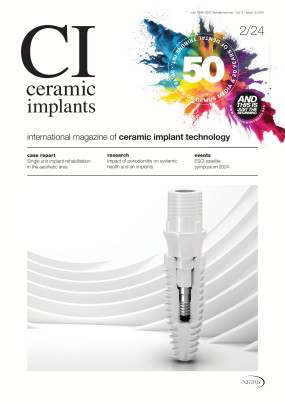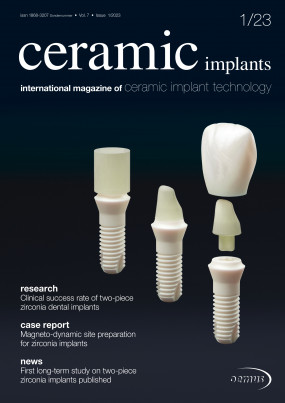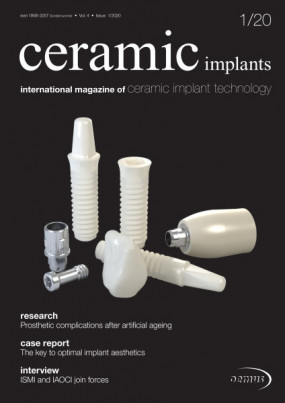Inhaltsverzeichnis
3
Around the world, fresh initiatives regarding ceramic implants technologies are being launched. In this issue of ceramic implants, we introduce two start-up companies from Poland and Spain which are devel-oping entirely new ceramic systems and will be establishing them on the market in the months and years to come. We spoke to Dr Jarosław Pospiech, implantol-ogist, engineer and inventor of the Polish implant system OriCera, about its novel screwless, detachable connection that requires neither adhesive nor cement. From Lidia M. Goyos Ball, medical devices division manager at Nanoker, we learn how the Spain-based company utilises two specific materials for its original ceramic implant system: a bioceramic composite on the one hand and a specific bacteriostatic bioglass coating on the other...
6
In traditional oral surgery and implantology, the focus lies mainly on the healing of an implant and the local factors that are necessary to preserve or grow bone and soft tissue. However, the view is still rather confined to the oral cavity. Classically, four methods of bone augmentation are considered: osteoinduction (growth factors), osteo-conduction (bone grafting material as space holder), distraction osteogenesis and guided tissue regeneration by means of membranes or the shell technique, among others...
10
Zirconia implant: Close to the natural root?
Dr Fabrice Baudot & Dr Giancarlo Bianca, France; Dr Pascal Eppe, Belgium
Titanium (Ti) implants are generally used to restore function and aesthetics following tooth loss.1 Numerous studies have demonstrated their excellent biocompatibility and high success rates.2, 3 However, the prevalence of peri-implantitis (PI) around Ti implants, should be a daily clinical concern due to their high incidence (Figs. 1a–c; resolution of the case shown in Figs. 8a & b).4 Recent studies have reported the presence of Ti particles around implants with PI compared to a healthy peri-implant environment.5, 6 Galvanic corrosion phenomena in the oral cavity could be related to the physiopathogenesis of PI.7 This issue takes up a large part in most of our confer-ences, and questions the reliability of our long-term implant treatments.8 The qualities of zirconia (ZrO2) ceram-ics as a prosthetic restorative material show us in daily use an extremely low bacterial colonisation, and allow soft tissues to act as a barrier to the underlying infection...
16
When it comesto aesthetics, ceramic implants are undoubtedly the better choice compared with titanium implants. Compared with titanium or titanium alloys, zirconium dioxide has some indisputable advantages. For example, for many users and patients, it is not only the fact of metal-free restoration that speaks in favour of this material but also the comparatively lower plaque affinity and high mechanical load-bearing capacity, combined with the better aesthetics...
20
A 62-year-old male patient was referred to the practice of the author after failed endodontic treatment of teeth #11 and 21, which had made the tooth roots mobile (Figs. 1 & 2). The patient had attended the practice several times in the past to have the central incisor crowns refitted, since they had kept falling off. Owing to the hopeless prognosis of the existing restorations, treatment options for restoring tooth #11 and 21 were discussed with the patient, who decided on extraction and replacement of these teeth with two dental implants...
24
Implant surgery according to the: All-In-One concept
Dr Corbin Popp, USA; Dr Rebekka Hueber & Dr Karl Ulrich Volz, Switzerland
The 72-year-old female patient presented on referral for a comprehensive biological approach to restore her failing prosthetic dental work composed of porcelain-fused-to-metal crowns and bridges (Fig. 1). Her motivations were to maintain overall health and to have lasting dental work with biocompatible materials. She had a history of trauma, multiple missing teeth, multiple root canal therapies, a history of recurrent decay and periodontal disease. Her occlusion appeared to have a mandible-to-cranial base discrepancy with significant first touch and slide coupled with multiple posterior interferences...
28
Tooth replacement with dental implants is considered the standard of care for replacing the natural tooth system in the contemporary practice of dentistry. Their success rates have been well documented in the dental literature over the last half century. Advances in surgical and prosthetic techniques have al-lowed for more conservative surgical approaches to pave the way to achieve more predictable wound healing and less soft tissue changes: critical issues in the aesthetic zone. Metal-free implant de-signs are proving to be an additional component to achieving natural soft-tissue emergence profiles and elim-inate the potential for soft-tissue complications that titanium implants and abutments present, especially in com-promised soft-tissue volume and thickness. The following article will demonstrate the immediate restoration procedure in the aesthetic zone with multiple implant placement and provisionalisation utilising one-piece metal-free implants...
32
In the early days of implant dentistry there was a strong focus on osseointegration to make sure that the implants stayed in the bone for a long time. In recent years, the focus has shifted to soft-tissue integration and different prosthetic components to realise long-term aesthetic results with healthy gingiva and stable tissue levels. However, the increased complexity of the solutions and the phenomenon of peri-implantitis has created a lot of challenges for current systems, jeopardising their long-term success. The implant system inserted in following clinical case (Patent™ Dental Implant System, Zircon Medical) has a patented surface and is significantly rougher than other systems...
36
Replacement of two incisors with zirconia implants
Prof. Curd Bollen & Dr Ilian Dargel, UK & Netherlands
Modern implant dentistry is a continuously changing discipline in which hightech approaches are involved to optimise the treatment results. An increasing number of cases are performed with guided surgery systems or even with navigated implant placement.1, 2 The complete digital workflow, including cone beam computed tomog-raphy (CBCT) scans, intraoral scans and prosthetic 3D printing, is nowadays gaining in importance.3 Moreover, we are seeing changing trends in the applied implant materials. For more than 60 years, titanium was the primary implant material used. Recently, a shift towards biological approaches can be seen in society overall: green energy supply, clothes recycling and biological food products. As a significant consequence, the use of more biocom-patible, metal-free and non-toxic materials in oral reha-bilitation is booming...
40
Treating stable periodontitis patients with two-piece implants
Drs Alaa Khutaba, Daniel Rotenberg & Hadar Zigdon-Giladi, Israel
n patients who suffer from periodontitis, the treat-ment with dental implants can pose unique challenges for clinicians. In most cases, periodontal therapy needs to be carried out first, before implants can be installed successfully. In the following, two clinical cases are described in which tooth replacement with dental implants was carried out once the patients had successfully com-pleted preceding periodontal therapie...
42
The patient, a 72-year-old male with well controlled hypertension, arthritis and an otherwise unremarkable medical history, presented with decay under the distal abutment of a long standing 4-unit fixed partial denture replacing teeth #15 and #16 (Fig. 1). Radiographic and clinical exams revealed an endodontically compromised #17, that was suspected to be vertically fractured. Also, tooth #18 was periodontally involved and unrestorable. The right maxillary sinus was pneumatised and the patient did not wish to have any sinus augmentation. The abutment tooth #14 exhibited coronal leakage and frac-tured porcelain, but was vital...
50
With INPERIO, the Spain-based manufacturing company Nanoker Research is entering the ceramic implant market with the goal of revolutionising dental implantology. In order to achieve this, the company utilises two specific materials: a bioceramic composite on the one hand and a specific bacteriostatic bioglass coating on the other. In this in-terview with ceramic implants, Lidia M. Goyos Ball, medical devices division manager at Nanoker, talks about the advantages of the company’s novel system...
52
The team behind Polish ceramic implant system OriCera is convinced that a new era in dental implantology will be dominated by metal-free products and that its implant will soon become the most advanced ceramic implant in the world and will contribute to improving the health and quality of life of patients worldwide. In this interview with ceramic implants, Chief Science Officer at OriCera Dr Jarosław Pospiech explains the rationale behind this ambitious view..






















